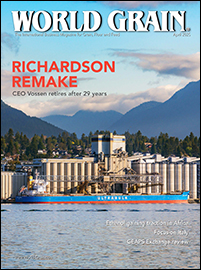Not only did the recent flooding in the Midwestern United States destroy thousands of acres of crops, it also damaged dozens of grain bins as well as the products stored inside of them. Grain bins exposed to flood waters are likely to be damaged and some grain loss can be expected. It is, however, often possible to repair bins and salvage at least part of the grain.
Water does not “wick” very far in whole grain, so it is likely that grain above the water line is still in good condition. Grain that was exposed to flood waters is usually contaminated by fuel, pesticides, and/or bacteria and grain in bins that have been damaged is often contaminated with metal, so it might be best not to try to salvage grain that was in contact with flood waters. But if it seems appropriate to try to salvage that very wet grain, quick action will be required to prevent spoilage.
Actions necessary for salvaging flood-damaged grain depend on the extent of damage to both bin and grain, so the first step is to inspect the bin, including the unloading and aeration equipment, and the stored grain. Then, contact your insurance company or disaster relief agency – or for organic producers, your certifier – as soon as possible to find out what you need to do to document losses and what they recommend for dealing with the grain.
The rate of spoilage for wet grain depends on its moisture content and temperature. Grain that was submerged for more than a few days will have a moisture content of about 30% to 50%. During warm weather, grain this wet will become moldy in a few days.
DEALING WITH WET GRAIN
The dry grain in the flooded bin will be relatively safe for a few weeks, but it would be best to separate it from the wet grain as soon as you can, because the wet grain will begin to spoil in a few days and generate mold, heat and odors that could reduce the quality of the dry grain above it. Try to unload the dry grain without mixing it with the wet.
Using a vacuum-type grain conveyor to suck the dry grain out the top of the bin might be the best way to do this. Consider selling the dry grain, moving it to an undamaged storage bin at your facility, or temporarily storing it in another building modified for grain storage.
If the grain moisture is not contaminated with fuel, pesticides, or bacteria and it is between 25% and 35%, consider ensiling it in an upright silo, plastic-covered horizontal silo or plastic silage bag. Be aware that grain in ruptured bins could contain bolts, bin hardware or other debris that should be separated out (consider using grain cleaners and/or magnets).Another option is to dry the wet grain in a gas-fired dryer. Be aware that after
drying, grain should be cooled to less than 60 degrees F (15 degrees C) for safe storage. It will be difficult to find weather cool enough to adequately cool grain that is dried during summer months.
If you can remove the dry grain from the top of the bin and get the fan going, you might be able to use unheated air to dry wet grain in bins equipped with full perforated floors and large drying fans. Chances of success for unheated air drying decrease as grain moisture, outside temperature and grain depth increase. If the grain is much wetter than 20% moisture, don’t use this drying method for more than about six feet (1.83 meters) of grain.
Under certain conditions, grain molds can produce mycotoxins that can cause animal feed refusal, health problems or even death. If grain develops a lot of visible mold, test for mycotoxins before spending money to dry it. Grain that is badly damaged by mold or has high levels of mycotoxins or other contaminants should probably be discarded.
UNLOADING WET GRAIN
It is not advisable to remove grain through the bin’s unloading system. If electric motors on the unloading system have been under water, it is best not to start them until they have been cleaned, dried and lubricated.
Extremely wet grain probably won’t flow out of the bottom-unloading sump anyway. Consider using a vacuum-type
grain conveyor to suck the grain out of the top of the bin.
If the water line was below the level of the side door on the bin, it might also be possible to insert an auger into the dry grain through a small opening in the side door. Make sure the auger extends to near the center of the bin, however, because unloading a bin from one side creates uneven sidewall pressures that can damage the bin.
ASSESSING WATER-DAMAGED BINS
It is not unusual to find structural damage to bins after floods. Because grain swells when it absorbs moisture, it exerts a great deal of pressure on the inside of bin walls, often resulting in stretched bolt holes, broken bolts and torn bin sheets. Sometimes, bins are knocked off their foundations or dented by the pressure of moving water or by impacts from floating debris. Rapidly moving water can also cause erosion around foundations.
Drying, aeration and unloading equipment on bins are likely to be inoperable immediately after floods. In many cases, however, electric motors
and controls and gas burners will work again after they are cleaned and dried. Don’t try to start electric motors until they have been cleaned and dried or they might burn out. You should also clean mud and debris off of fan blades to prevent imbalances that might lead to bearing damage.
In many cases, aeration ducts and areas under full-perforated floors will contain mud and saturated grain fines. Clean these areas before the bin is filled again.
Companies that work on grain bins are likely to be quite busy after widespread flooding, so if repair work is needed, try to line up a contractor as soon as possible to get bins repaired before the next harvest.
If the bin has an elevated, full-perforated floor and the water level remained below the floor, the grain is probably fine. You might still need to check for erosion around the foundation, damage to the fan and unloading system, and mud accumulation under the floor.
If grain rests directly on a concrete floor, it is possible that water moved up through small cracks and pores and soaked a few inches of grain next to the floor. It is also possible that in-floor aeration ducts are full of water and mud, and that the fan and unloading system have been damaged by water.
If you can get the aeration system to work, attempt to dry the layer of wet grain by aerating it. Or, if you can get the unloading system to work, consider transferring grain from one bin to another to get the layer of wet grain off the floor before it molds.
Possible safety hazards include electrical short circuits, gas leaks, sudden rupture of weakened bins, entrapment in flowing grain and breathing dust and mold spores from damaged grain. Turn off gas valves and electrical power until you have a chance to clean, dry and inspect gas and electrical systems. Work in pairs and stay out of flowing grain. And finally, wear a tight-fitting, high-quality dust mask or respirator that is designed to filter mold spores and other toxic dusts when handling flood-damaged grain.
Bill Wilcke, extension engineer, University of Minnesota, Bioproducts and Biosystems Engineering Department.




